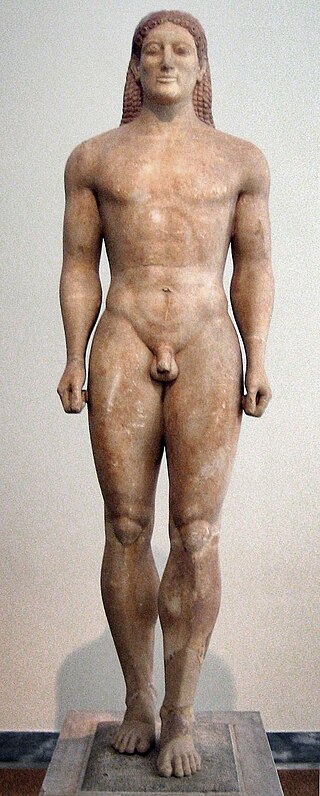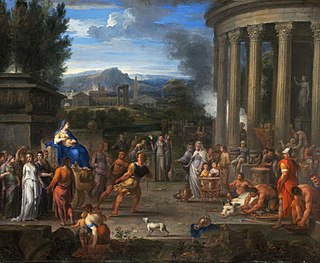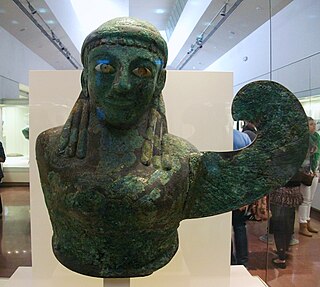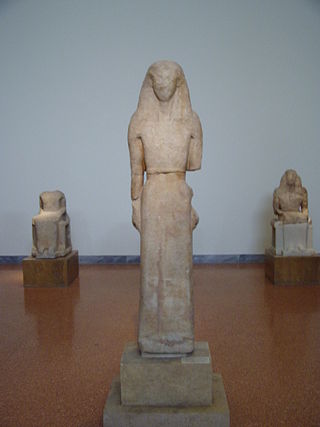
In Greek mythology, Daedalus was a skillful architect and craftsman, seen as a symbol of wisdom, knowledge and power. He is the father of Icarus, the uncle of Perdix, and possibly also the father of Iapyx. Among his most famous creations are the wooden cow for Pasiphaë, the Labyrinth for King Minos of Crete which imprisoned the Minotaur, and wings that he and his son Icarus used to attempt to escape Crete. It was during this escape that Icarus did not heed his father's warnings and flew too close to the sun; the wax holding his wings together melted and Icarus fell to his death.

Praxiteles of Athens, the son of Cephisodotus the Elder, was the most renowned of the Attica sculptors of the 4th century BC. He was the first to sculpt the nude female form in a life-size statue. While no indubitably attributable sculpture by Praxiteles is extant, numerous copies of his works have survived; several authors, including Pliny the Elder, wrote of his works; and coins engraved with silhouettes of his various famous statuary types from the period still exist.

Kouros is the modern term given to free-standing Ancient Greek sculptures that depict nude male youths. They first appear in the Archaic period in Greece and are prominent in Attica and Boeotia, with a less frequent presence in many other Ancient Greek territories such as Sicily. Such statues are found across the Greek-speaking world; the preponderance of these were found in sanctuaries of Apollo with more than one hundred from the sanctuary of Apollo Ptoion, Boeotia, alone. These free-standing sculptures were typically marble, but the form is also rendered in limestone, wood, bronze, ivory and terracotta. They are typically life-sized, though early colossal examples are up to 3 meters tall.

The relatively small limestone Cretan sculpture called the Lady of Auxerre, at the Louvre Museum in Paris depicts an archaic Greek goddess of c. 650 - 625 BCE. It is a Kore ("maiden"), perhaps a votary rather than the maiden Goddess Persephone herself, for her right hand touches her solar plexus and her left remains stiffly at her side. It is also possible that the Kore is a depiction of a deceased individual, possibly in a position of prayer.

The sculpture of ancient Greece is the main surviving type of fine ancient Greek art as, with the exception of painted ancient Greek pottery, almost no ancient Greek painting survives. Modern scholarship identifies three major stages in monumental sculpture in bronze and stone: the Archaic, Classical (480–323) and Hellenistic. At all periods there were great numbers of Greek terracotta figurines and small sculptures in metal and other materials.

Chryselephantine sculpture is a sculpture made with gold and ivory. Chryselephantine cult statues enjoyed high status in Ancient Greece.

The Temple of Zeus at Olympia was an ancient Greek temple in Olympia, Greece, dedicated to the god Zeus. The temple, built in the second quarter of the fifth century BC, was the very model of the fully developed classical Greek temple of the Doric order.

Classical sculpture refers generally to sculpture from Ancient Greece and Ancient Rome, as well as the Hellenized and Romanized civilizations under their rule or influence, from about 500 BC to around 200 AD. It may also refer more precisely a period within Ancient Greek sculpture from around 500 BC to the onset of the Hellenistic style around 323 BC, in this case usually given a capital "C". The term "classical" is also widely used for a stylistic tendency in later sculpture, not restricted to works in a Neoclassical or classical style.

A xoanon was a wooden cult image of Archaic Greece. Classical Greeks associated such cult objects, whether aniconic or effigy, with the legendary Daedalus. Many such cult images were preserved into historical times, though none are known to have survived to the modern day, except as copies in stone or marble. In the 2nd century CE, Pausanias described numerous xoana in his Description of Greece, notably the image of Hera in her temple at Samos. "The statue of the Samian Hera, as Aethilos [sic] says, was a wooden beam at first, but afterwards, when Prokles was ruler, it was humanized in form". In Pausanias' travels he never mentions seeing a xoanon of a "mortal man".

In the Archaic phase of ancient Greek art, the Orientalizing period or Orientalizing revolution is the cultural and art historical period that began during the later part of the 8th century BC, when there was a heavy influence from the more advanced art of the Eastern Mediterranean and the Ancient Near East. The main sources were Syria and Assyria as well as Phoenicia and Egypt. With the spread of Phoenician civilization by Carthage and Greek colonisation into the Western Mediterranean, these artistic trends also influenced the Etruscans and early Ancient Romans in the Italian peninsula.

Prinias is an archaeological site in Crete that has revealed a seventh-century BCE temple with striking similarities to ancient Egyptian architecture, including an Egyptianised seated goddess. It is 35 kilometres (22 mi) southwest of Iraklion, about halfway between Gortyn and Knossos. Above the site is a peak sanctuary, a sub-Minoan survival.

The Severe style, or Early Classical style, was the dominant idiom of Greek sculpture in the period ca. 490 to 450 BCE. It marks the breakdown of the canonical forms of archaic art and the transition to the greatly expanded vocabulary and expression of the classical moment of the late 5th century. It was an international style found at many cities in the Hellenic world and in a variety of media including: bronze sculpture in the round, stelae, and architectural relief. The style perhaps realized its greatest fulfillment in the metopes of the Temple of Zeus, Olympia.

Kleobis (Cleobis) and Biton are two Archaic Greek Kouros brothers from Argos, whose stories date back to about 580 BCE. Two statues, discovered in Delphi, represent them.

A sphyrelaton is a term used for a type of archaic Greek bronze votive statues of considerable size.
The Sounion Kouros is an early archaic Greek statue of a naked young man or kouros carved in marble from the island of Naxos around 600 BCE. It is one of the earliest examples that scholars have of the kouros-type which functioned as votive offerings to gods or demi-gods, and were dedicated to heroes. Found near the Temple of Poseidon at Cape Sounion, this kouros was found badly damaged and heavily weathered. It was restored to its original height of 3.05 meters (10.0 ft) returning it to its larger than life size. It is now held by the National Archaeological Museum of Athens.

The Dedication of Nikandre is a Greek marble sculpture, made approximately around 650 BCE, held in the National Archaeological Museum, Athens, Greece. Nikandre, a woman from the island of Naxos, dedicated the statue in the temple of Artemis at Delos, the birthplace of Apollo and Artemis. The statue, which was found during archaeological excavation in the 19th century, is one of the earliest surviving korai, or statues of women, and displays one of the oldest inscriptions of Ancient Greek in stone. Its representation and its placement within the existing stylistic periods of Greek sculpture have become the subject of extensive scholarship.

Ancient Greek art stands out among that of other ancient cultures for its development of naturalistic but idealized depictions of the human body, in which largely nude male figures were generally the focus of innovation. The rate of stylistic development between about 750 and 300 BC was remarkable by ancient standards, and in surviving works is best seen in sculpture. There were important innovations in painting, which have to be essentially reconstructed due to the lack of original survivals of quality, other than the distinct field of painted pottery.

The Korai of the Acropolis of Athens are a group of female statues (Korai), discovered in the Perserschutt of the Acropolis of Athens in the last quarter of the nineteenth century, all of the same typology and clear votive function. Through them it is possible to trace the stylistic evolution of Archaic Attic sculpture for almost a century, from 570 to 480 BC. This demonstrates in particular the beginning and development of Ionian influence on Athenian art of the second half of the 6th century BC. This was the period when Ionian elements first appear in the architectural works of the Peisistratids and close connections between Ionia and Athens developed. Towards the end of the 6th century BC this influence is seen to be overcome, or rather absorbed, and a new style is born, the so-called Severe style, with increasing Peloponnesian influence.

The New York Kouros is an early example of life-sized statuary in Greece. The marble statue of a Greek youth, kouros, was carved in Attica, has an Egyptian pose, and is otherwise separated from the block of stone. It is named for its current location, at the Metropolitan Museum of Art in New York City. The Metropolitan Museum of Art said in "Marble statue of a kouros (youth)" that "The statue marked the grave of a young Athenian aristocrat."

Archaic Greek Sculpture represents the first stages of the formation of a sculptural tradition that became one of the most significant in the entire history of Western Art. The Archaic period of Ancient Greece is poorly delimited, and there is great controversy among scholars on the subject. It is generally considered to begin between 700 and 650 BC and end between 500 and 480 BC, but some indicate a much earlier date for its beginning, 776 BC, the date of the first Olympiad. In this period the foundations were laid for the emergence of large-scale autonomous sculpture and monumental sculpture for the decoration of buildings. This evolution depended in its origins on the oriental and Egyptian influence, but soon acquired a peculiar and original character.




















